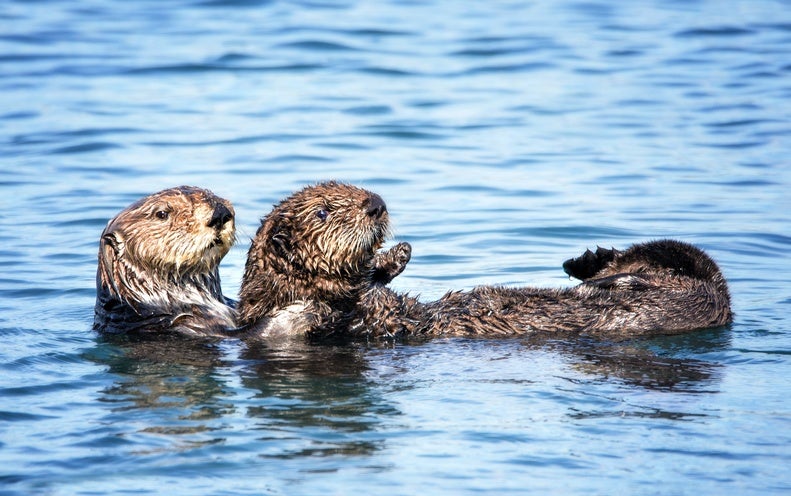
Once hunted to the brink of extinction for their luxuriant pelts, California sea otters rebounded after protections were put in place in 1911. Their population grew steadily for much of the last century, but now the still-threatened species is stuck at about 3,000 otters. The problem is that they are boxed in at both ends of their current range, along the state’s central coast, by a sharp (and so far unexplained) rise in shark attacks. Hoping to reintroduce breeding populations elsewhere in the otters’ historical range, wildlife managers have been looking at certain coastal estuaries, which are sheltered pockets of water.
It turns out that the largest estuary on the West Coast—San Francisco Bay—could potentially provide an excellent home for sea otters despite being in the middle of a major urban area, according to a study published last month in PeerJ.
“I was surprised,” says study lead author Jane Rudebusch, a spatial ecologist at San Francisco State University's Estuary & Ocean Science Center. “The bay is intensely urbanized. You can tell it's a busy place just by looking at it.” Tanker ships deliver crude oil to shoreline refineries every day, and high-speed commuter ferries constantly zoom between San Francisco, Oakland and other waterfront cities at up to 50 miles per hour. Sediment in parts of the bay is laced with methylmercury and polychlorinated biphenyls, toxic chemicals that accumulate in the clams, crabs and other animals that sea otters eat.
Rudebusch and her colleagues used existing data to create a map of the bay showing these risks by specific region, as well as the quality of possible sea otter habitats—particularly shallow water and salt marshes. They found the bay still has hundreds of acres of high-quality habitat in areas where the danger from human threats is low. “A large part of the north bay is a sweet spot,” Rudebusch says. Much of this area is only about three feet deep and has ample salt marsh in protected areas including China Camp State Park and the San Pablo Bay National Wildlife Refuge.
Rudebusch is optimistic that sea otters can coexist with the many human uses of the San Francisco Bay, but she emphasizes that her work is an early step in a long process. She also cautions that, before wildlife managers can even think about reintroducing sea otters, “there needs to be a lot more groundwork to optimize the chances of success.”
One question is whether the north bay offers enough food for sea otters, which consume the equivalent of about one quarter of their body weight every day. A companion study published in PeerJ in 2019 found that the entire bay has enough prey to feed about 6,600 sea otters. But that study did not map food abundance in specific parts of the bay. “The next big thing is assessing prey availability spatially," Rudebusch says. "The otters will go where the food is. Will it line up with the north bay sweet spot, or in high-risk areas?”
Also unknown is whether sea otters would stay put where they are reintroduced. “It's impossible to predict what they'll do,” says Tim Tinker, a sea otter expert at the University of California, Santa Cruz, who was not involved with the new study but did contribute to the one published in 2019. He suggests trial reintroductions in smaller estuaries just north of the San Francisco Bay. These include Tomales Bay, which is in a state park, and Drakes Estero, in Point Reyes National Seashore. Such test runs would help determine whether reintroduced otters are likely to stay in estuaries, as well as the best sex and age mix for establishing new populations. “These are all things that need to be thought through before reintroducing otters to the San Francisco Bay could become a reality,” Tinker says.
Another factor to consider is the local reaction to reestablishing sea otters. Members of the fishing industry, for example, might be leery of these voracious predators. There are no longer any commercial fisheries in the bay itself, but it remains a major nursery for young Dungeness crabs that migrate out to the ocean where they are harvested as adults. And shoreline property developers may oppose the return of sea otters because, as a protected species, their presence would add a layer of regulation to projects.
Many conservationists, on the other hand, would be thrilled at the prospect of bringing sea otters back to the bay. Letitia Grenier, an ecologist at the nonprofit San Francisco Estuary Institute who was not involved with the study, notes that the bay is already rich in wildlife ranging from salmon to migratory birds to humpback whales. The latter have recently started returning to feast on huge schools of anchovies. “The bay has so much space—hundreds of thousands of acres,” she says. “We ought to be able to share it with sea otters.”
December 28, 2020 at 06:45PM
https://ift.tt/3aMBUVv
Sea Otters Could Get New Home in San Francisco Bay - Scientific American
https://ift.tt/2CoSmg4
Sea
/cloudfront-us-east-2.images.arcpublishing.com/reuters/CZF6NULMVVMEXHOP7JK5BSPQUM.jpg)
No comments:
Post a Comment